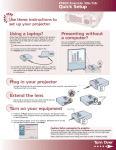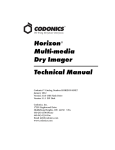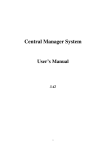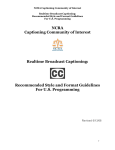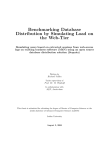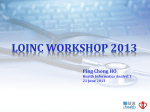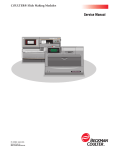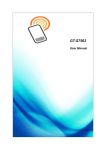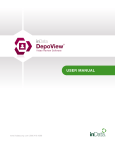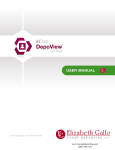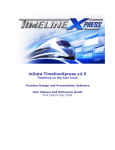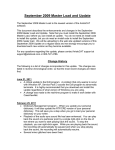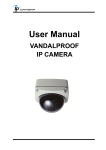Download iPad Products
Transcript
Abstract This paper seeks to explain the reason behind this white paper, the benefits of modern courtroom technology and other issues surrounding it, and finally gives an extensive evaluation and comparison of the leading competitive trial presentation software. Foreword by Bill Roach Author: Ji.in Chung Date: July 2011 2 Contents Foreword by Bill Roach…………….………………………………….………………….………………….4 Key Features………………………………………………………………..………………….………………….9 ExhibitView 4.1………………………………….……….…………….………………………….…..9 TrialDirector 6…………………………………….………………………………………………....12 Sanction II………..…………………..………….………………....………...........................14 Trial Smart…………….…………..….………………………….………..………………………….15 PowerPoint 2010………….….………………………….………………….……………………..17 Product Comparisons…………………………………….………..………………………………..………19 Comparison Chart………………………………………….……………………………..……………..…...24 iPad Products…………...……..……………….……….……………………………………...................28 The Importance of Trial Presentation Technology by Bob Finnell, Esq…..….….……29 A Paralegal’s Trial Presentation Software Comparison.……………………..…….…....….30 Conclusion……………………………………………………………………….…………………………...…..32 3 Foreword By Bill Roach (Co-Creator of ExhibitView) History and Why of this White Paper The 21st century courtroom is looking more and more like the movie “Minority Report,” starring Tom Cruise. Where you will have virtual screens right in front of you and use your hands and fingers to swipe information in and out, expand, enlarge and show a group of people just the information you desire. This technology really cuts down the time necessary to show a group of people important information relevant to your story. I use the word “story” because in the end, an attorney is charged with telling the story of his/her client and persuading 12 unbiased fellow citizens that his/her story is the only true and accurate account. This holds true for both Defense and Plaintiff attorneys as well as prosecutors and defenders. It’s here already! The technology of swiping our hands and moving evidence in and out and in front of jurors is already here. The big virtual monitor is not. That said, the days of presenting evidence and exhibits in court are starting to get really exciting. Why this White Paper? We, ExhibitView Solutions, LLC, a company of trial lawyers, IT professionals and software developers have seen that the legal industry is lacking in thorough and detailed information about courtroom technology and specifically, presentation technology. I have been giving a seminar, offered with CLE credit in some states, called “Trial Technology in the Courtroom”, by Bill Roach. This 1 hour program, elements of which are included in this white paper, seeks to 4 educate the modern trial lawyer about digital media, and methods of presenting in the courtroom. There is so much to understand that I hope this white paper helps you understand what your options are, the technology challenges, and we’ll address media types/formats. Gone are the days when a lawyer won’t need to know if his video is in the DVD format, a MPEG1 file for playback on a laptop, or a MP4 video file for playback on your iPad. You really help your cause when you take a little time to get familiar with the following Digital Media Formats. (Kind of like the 4 Food Groups ) 1. Audio/Video Formats a. Audio, .MP3 (universal format for PC, iTunes, MP3 players, Mac, etc) b. Audio, .WAV (Windows PC) c. Audio, .AIFF (Mac typically) d. Audio, .WMA (Windows PC) e. Video, DVD (self-contained MPEG2 video files. May be extracted if you know how) f. Video, .MPEG 1 & 2 (Windows PC) g. Video, MP4 (Mac, now PC, iPod & iPad) h. Video, .AVI (Windows PC) i. Video, .WMV (Windows PC) 2. Image Formats (Typically there is complete crossover between image formats for PC, Mac, iPod, iPad) a. JPG, GIF, TIF, PNG, BMP b. http://www.wfu.edu/~matthews/misc/graphics/formats/formats.html This website is an excellent resource for a wonderful explanation of file formats and types. It would take me 2 pages to explain. Since all these formats are useable in most products these days, the thing to be aware of is “HOW BIG IS THE FILE”. The goal in modern technology is to make everything smaller, while keeping the quality (ever heard of the iPad?). So, new file formats come along that offer better quality and lower file size. 3. Document Format Types a. .TIF (PC or Mac, a very good quality, lower file size format that allows multi-page formatting. However, the multi-page angle is interpreted because a multi-page .tiff is actually one single image file that is really, really, long. This is still widely used for images actually, and documents in the legal community) b. .PDF (The newest, most widely used format for documents.) 5 c. WORD, EXCEL, WORD PERFECT (Ok, now these are Microsoft Office & you knew that) Using MS Office documents inside other products, presentation software or slideshow software requires a simple conversion. It is built into MS office and allows the Office item to become a simple PDF or other format. 4. DEPOSITIONS a. We add this because of legal. Depositions are sent to law firms as: i. PDF files (no video taken) ii. ETRAN (no video taken) iii. ASCII text (no video taken) iv. Synchronized video depositions (when video has been taken) 1. Synchronized depositions can be the most useful because it marries the text of the transcript along with the video for easy retrieval of important testimony. This quick retrieval is great for review or playback in court. v. DVD Deposition video (when video has been taken) Current Deposition Products Available (& the Presentation Integration Consideration) Deposition Transcripts with/out video taken: a. PDF. Great & most compatible. b. ETRAN. Good for review & allows for printing, reprinting & save as ASCII. c. ASCII text. Good for importing/adding to various presentation software. d. West bundle CAUTION West is spending lots of capital promoting this bundle of transcripts, with or without video as a convenient way to organize and review depositions. Many of us in the legal industry, IT Professionals, court reporters, see that the lack of easy “export to _____ presentation software” may lead to huge additional costs and headaches for attorneys and law firms trying to organize and present deposition testimony. e. DepoView An excellent, multi compatible video deposition, with transcript text, and review tools that include various methods of saving into other formats for use in various presentation products. f. YesLaw CAUTION A lesser known Synchronized deposition review tool with fewer tools to export. Some court reporter and videographers sell this brand and in my own experience as an IT services company, the attorneys involved in the case either: i. Never knew what format they were getting ii. Were never told about any options available to them 6 iii. Were never asked what kind of presentation software they used to ensure compatibility iv. Are left to pay the bill to convert these lesser compatible products into useable form Q. Are all of these filing format choices and products the responsibility of the Attorney or the Provider to ensure ease of use? A. THE PROVIDER SHOULD INQUIRE AND OFFER THE MOST COMPATIBLE PRODUCTS, OR THE NECESSARY PRODUCTS FOR THE ATTORNEY AND HIS/HER FIRM! NCRA Trial Presentation Professional Workshop & Certification Program There has been a movement in the last few years to create a certificate program for trial presentation professionals. http://ncraonline.org/certification/certificates/tp/default.htm I have met some of the professionals who have worked to create this program through the NCRA. Certainly the idea is great. If your law firm can bring more of the presentation skills in house, you will save yourself and your clients BIG MONEY. I myself still offer courtroom presentation services for 1,500.00/day. See below: There will always be a need for these services, for sure, and don’t misquote me on that. I have seen and been a part of very complex litigations and having myself or another experienced IT person at your side can make all the difference. We are often told that more and more cases just don’t pay to hire someone. These are cases that law firms plan to use their own technology and their own staff. I encourage you to take the 2 day workshop and get your certificate. It is not a court requirement and it should prove helpful and educational. 7 A Forward on what is Currently Available The number of products available for the modern lawyer has grown in recent years. What was once a niche industry, and still is to some degree, making courtroom presentations can be effectively handled by the attorney, paralegal and/or other law firm staff who can click a mouse. Market forces and economy drive innovation and cost saving measures. This very reason is why we, ExhibitView Solutions, LCC created our simple, powerful, PDF friendly courtroom presentation software called “ExhibitView”. A product you can learn in 30 minutes! That said we want you to know what else is out there. I have asked many attorneys and paralegals to share the research they have had done on the field of products (see the end of this White paper for one of those independent, internal research reports on all the players) and we consistently WIN the business and as such, we are not afraid of talking about everyone. We will continue to dominate the easy-to-use category and respond to our customer’s needs and requests. The field consists of the following products: 1. ExhibitView by ExhibitView Solutions, LLC 2. TrialDirector by InData Corp. Old dog, training required, database app. However, these folks make some other nice software for synchronizing depositions & making timelines. 3. Sanction by Sanction Solutions Old dog, training required, database app. 4. TrialSmart by Clarity Legal Starts cheap and bundles everything to make the cost and training higher than most. 5. PowerPoint by Microsoft Office Can’t use PDF multipage or even crop a PDF, ExhibitView can. 6. iPad Products Many players are coming onto the scene. NOT a complete solution in any sense of the “trial presentation” world. Worth looking at and considering and keeping an eye on this technology! 8 Key Features ExhibitView™ 4.1 ExhibitView, the newest trial presentation software program released in 2009, specializes in on the fly slide presentations with exclusive features that distinguish it from its competitors. The 4 main tabbed areas at the bottom of the screen are: Presentation Area, SlideMaker LE, WebViewer, and Plugin Apps. (see Diagram A) Diagram A Thumbnails are previewed in the left hand column. Single click or drag & drop slides onto Presentation Area to view larger. (Side by side (70/30) shown) The Presentation Area tab is highlighted at the bottom of the screen 1 Presentation Area: Single click or drag & drop any asset* to view full screen or side by side (50/50) (70/30) (30/70). (see Diagram A) *Asset: a slide, a document, an image, an audio/video clip, or saved web pages 2 SlideMaker LE: Finally a tool that lets the user create PDF friendly slideshows without having to extract PDF pages. Select page, crop and enlarge PDF single or, multi page documents. Create or add pre-existing background to enhance slideshow presentations. Importing a presentation from PowerPoint is also possible when creating a new slideshow. Main screen of SlideMaker LE. Close-up of “Import From 9 PowerPoint” button. This valuable feature saves time by not having to recreate the presentation again. SlideMaker LE can also create an unlimited number of “independent” slideshows inside a single presentation. 3 WebViewer: This exclusive feature can surf the web, save web pages as PDF files, or save Facebook pages as snapshots. Send a page to the projector during a presentation all without distracting the audience. WebLive lets you browse and display web pages live. This is great for viewing videos or animations online and saves time otherwise from downloading and converting the files. ExhibitView’s WebViewer 4 Plugin Apps: Another exclusive feature that allows for unlimited expansion & addition of Apps to increase ExhibitView’s capabilities without complicating the basic user interface. Plugin Apps sets ExhibitView above the others in that it can easily upgrade to the latest App technology by simply adding it here. ExhibitView’s current & ever expanding Plugin Apps 1. SynchPro: Bookmark, Edit & Synch Digital Video Transcripts (DVT). 2. Transcript Pro: Bookmark with Notes, Highlight Testimony, Instantly Present Q&A to the Jury, & Add Unlimited Transcripts in the ASCII format. 3. OCR (coming soon!): This App searches the text of any document using key words. Slides are vertically organized. To view the slides before projecting them, they are simply clicked on once, or dragged & dropped onto the Presentation Area. (see Diagram A) All of your slides/shows can be viewed under the Slides tab simultaneously without having to open them up one by one. This is useful for quickly viewing all of your slideshows and makes it easy to transfer files among different slideshows. Preview all of your assets, slides & slideshows at once. 10 A unique feature to ExhibitView is the presentation output. In the presentation mode, all that is presented are the assets in the presentation area. There are no menu bars or buttons cluttering the screen. Similarly, the mouse pointer is not visible in the output. This is called GhostPointer Technology. The audience does not see the presenter using the software; they only see what is sent to the projector. Clean presentation output allows the audience to focus on the slides not on the program. ExhibitView can annotate or markup assets during a live presentation. Besides the basic zoom in/out function, the presenter can also zoom in or “tear out” a section of a document for further speculation and can annotate or markup as well. ExhibitView can play and bookmark a/v clips (audio & video) and DVD’s. It can also view the following common file extensions: Documents – DOC, DOCX, XLS, XLSX, TXT, RTF, PDF & TIF Images – JPEG, GIF, BMP & PNG Audio/Visuals – MP3, WAV, M1A, M1V, MPEG, AVI, WMA, WMV Error Correct is unique IP feature, allowing the presenter to discreetly modify slides by updating, adding, or fixing them as they are presenting live. The audience only sees the updated slide. There is no need to close down a presentation for simple changes to slides. Error Correct Access button in bottom right corner A new feature lets you create an unlimited amount of Virtual Subfolders located next to the My Favorites tab near the top in the left-hand column. Virtual Subfolders tab is to the right of My Favorites tab A current disadvantage is that it does not yet have the capability to overlay exhibit stickers or code documents with multiple data fields, and lacks presentation security features that add privacy. (Although you can run ExhibitView as a user in a tightly secure laptop.) But with the Plugin Apps, adding these special features would not be difficult. A current BIG advantage is that ExhibitView handles multi-paged PDF’s with ease. The user only 11 has to drag & drop the multi-paged PDF file onto the SlideMaker LE area and they can instantly resize or flip to another page to edit. ExhibitView users will never lose data, or have to “relink missing files” because the original files are copied into a separate ExhibitView folder. Other litigation database programs link the files to their originals, making it cumbersome to reorganize folders without having to manually relink them. Lastly, ExhibitView’s annual software assurance fee is by far the most generous. The fee includes unlimited online training with a trial expert, updates and upgrades, and advanced support via email, telephone and online. TrialDirector® 6 InData’s TrialDirector is one of the older trial presentation software programs among law firms. On the left-hand column is the Case Explorer where all of the files are managed. Cases are further divided into Document, Multimedia, and Transcript subfolders. Add files by dragging and dropping into these folders. The Workbooks Explorer at the bottom of the left-hand column is used to organize Trial Exhibits. (see Diagram B) TrialDirector’s database feature links all of your documents, which is great for saving internal memory. However, once you move those original files, TrialDirector can no longer locate them. Its latest version now has a new Reconnect Missing File Links wizard that identifies missing files to quickly reconnect them. This may be helpful, but time is still wasted manually relinking all of those moved files. There are 4 tabbed areas at the bottom of the screen: Case Library, Document Manager, Transcript Manager, and Coding. Diagram B 12 TrialDirector’s main screen with sample image. The 4 tabs are shown at the bottom left-hand corner. 1 Case Library: The main default area where images & documents can be viewed & organized. There are sub-tabs that appear near the top menu bar: Images, Native (Adobe Acrobat Reader is built-in here to view native files in PDF), Text, & Presentation View. 2 Document Manager: This reduces the folders to only the Document subfolder for managing. 3 Transcript Manager: View, Edit, & Synch ASCII transcripts & multimedia files. Edit by using the Segment Editor feature & search transcripts by word or phrase. The sub-tabs are: Transcript, Clip Editor, and Search. 4 Coding: Code documents here. Coding such as date, title, author, etc, help to organize files & also facilitate the searching process in the future. Sub-tabs are Image, Native, and Text. During presentation mode, a menu bar is present at the bottom of the screen for annotating or for searching documents to call up, and can be minimized or hidden. The menu bar is customizable and can be saved and loaded as needed. TrialDirector’s presentation mode menu bar & “Projection Zoom” feature A new feature called “Projection Zoom” has nice appearance effects, but the zoom percentage is already defined and one cannot pan the zoomed in area. Like ExhibitView, TrialDirector can also view multi-paged PDF documents. Unlike ExhibitView, TrialDirector can only edit, clip, and play DVT files, not DVD’s. Digital Video Transcripts, or DVT files are created synchronizing video to transcript text. This process involves first converting the video file using a separate software program, which is inconvenient for those who have a CD/DVD at hand. A common filing system for courtroom exhibits is the use of barcode numbering. The documents are scanned in and organized according to their barcode number. TrialDirector can assigns barcodes to documents for printing. This comes in handy when searching for documents while presenting. 13 The new Pack-N-Go feature packs up cases and unpacks them into any computer installed with TrialDirector. This is helpful for quick transfers to laptops for trials. TrialDirector is also compatible with other popular litigation programs, such as Summation iBlaze, Summation Enterprise, Microsoft PowerPoint, TimelineXpress and Microsoft Office 2010. TrialDirector 6 is no longer capable of displaying live internet content, through a URL, while presenting. Lastly, there are annual maintenance fees. Sanction II Sanction, by Verdict Systems released in 1999, is another one of the older trial presentation software for the courtroom. It was created as a lighter alternative to TrialDirector and other competing litigation programs. Like TrialDirector, it is mainly a document databasing program, with basic trial presentation features including drag & drop, and annotation tools to markup documents. Sanction is limited, however, to 2 GB’s of database memory and cannot handle case data sets over 100k’s. Verdict Systems offers an upgrade from Sanction to Verdical, which can handle up to 4 GB’s and has many more features. Sanction’s main screen has 4 tabs at the bottom: Main Screen, Clip Creator, Coding, and Transcript Search. (see Diagram C) Diagram C Sanction’s main screen with sample image. The 4 tabs are at the bottom left-hand corner. 14 1 Main Screen: View images & documents here. 2 Clip Creator: Create clips from videos & view its corresponding transcript side by side. 3 Coding: Code documents for better organization. There are two sub-tabs near the top menu: Display, & Find/Query. 4 Transcript Search: Search transcripts using key words. There are 9 tabs or layers at the bottom of the screen where you can overlay exhibits. Sanction only supports TIF images, which means that frequent conversion of files must first take place before importing them into Sanction. It does support PDF files, but a PDF Plugin must be purchased separately. The embedded OCR (Optical Character Recognition) feature can import or extract text from TIF and PDF files. The presentation screen output, like TrialDirector, has a menu bar at the bottom for markups, zooming, and calling up other digital evidence. Sanction’s menu bar in presentation mode. Graphics & Icons are Out-Dated. Sanction is integrated with Third Party Applications so that transferring data from other litigation programs (e.g. Summation, Concordance, LiveNote, CaseMap, & TimeMap) minimizes "duplication of work." Sanction also has annual maintenance fees, which is costly over time. TrialSmart Since its release in 2005, Clarity Legal’s TrialSmart was only available for Mac. It has just recently been available for Windows and Linux. 15 TrialSmart is just one of four other litigation programs they offer. TrialSmart is for creating trial presentations, DocSmart is for document databasing, DepoSmart is for annotating and editing transcripts, and finally, Bundler is for court reporters and allows them to “bundle” all of the media onto a CD for dispersing. ClarityViewer is a free-to-download viewer for those who need to view transcripts but do not own any of their products. To do what its competitors can do, one would need to purchase all four software programs. (see Comparison Chart) TrialSmart has a simplified, uncluttered interface due to its lack of features. It only creates trial presentations and is designed to work with its sister software. Clicking on images, videos, text, etc. pops up a new window where you can arrange them to your liking. However, this clicking and moving constantly can seriously hinder the workflow process. Multiple pop-up windows slow down the workflow. Files supported are: TIF, PNG, JPG, and BMP images, PDF files, and can export video clips in Mpeg. Similar to TrialDirector and Sanction, the presentation screen output has a menu bar at the bottom for annotating, zooming, and call-ups. TrialSmart, like ExhibitView and TrialDirector can also have two zoom boxes from two different documents that are being shown side by side. TrialSmart’s presentation output where a menu bar runs along the bottom. Two zoom boxes are shown from two different documents. TrialSmart, like Sanction, also has 9 tabs or layers at the bottom of the screen for overlaying exhibits. Although TrialSmart lacks the much needed integration that lawyers need, one can make up for it either by purchasing DocSmart, or by linking the files to an external database (e.g. Dropbox). Unlike TrialDirector and Sanction, TrialSmart offers free video tutorials on their website. They are limited and so in-depth training is offered at an additional cost. 16 PowerPoint 2010 Microsoft Office PowerPoint 2010 is a presentation software that can be used by people of all industries. It allows one to create presentations quickly and easily. The Ribbon, or menu bar, makes use of context driven icons and text, and is divided into multiple tabs. These tabs are further divided into sections or groups. PowerPoint 2010 default screen Many of the basic text editing features inside PowerPoint are identical to Microsoft Office Word. Although PowerPoint can create flashy slideshows with 2D and 3D animations, one thing that it lacks is compatibility with multi-paged PDF documents. The Presenter View, when using dual monitors or a projector, includes a speaker’s notes* section, time lapse, and fade out effect. * ExhibitView planned for future versions. Close-up of left-hand column and Ribbon. View thumbnails of slides. In the Presenter View, one can markup slides and read from notes previously typed in edited mode. It also allows the user to choose slides out of order. 17 PowerPoint Presentation Output PowerPoint Presenter View Other Features: Background Templates, Create Charts & Graphs, Clip Art / Word Art / SmartArt, Customizable Themes, Animated Slides / Text Transitions, Sound Effects, Record Narration (played back during slideshow), Rehearsed Timings, Spell Check, Translate, Auto Advance Slides Auto (timed), Research: Built in Encyclopedia, Thesaurus, Dictionary, & more. Some New Features are: Backstage View, Organize Slides into Sections, PowerPoint Web Apps (work from anywhere), PowerPoint Mobile, Bookmark & Trim a/v Clips, Apply Artistic Textures & Effects to Pictures, Remove Background from Pictures, Precision Crop, New SmartArt Graphic Picture Layouts, Transitions with 3D Motion Graphic F/X, Broadcast your Slideshow to Remote Audience, and Turn Mouse into Laser Pointer. The shear multitude of features and newly added ones inside PowerPoint 2010 can be very overwhelming. This makes it quite daunting for those who lack time to learn and figure out a new software program. This holds especially true for attorneys who will not use all of the flashy features of PowerPoint. There are many (free) video tutorials online at Microsoft, and other websites to help you learn all of the features and make the most of what PowerPoint has to offer. 18 Product Comparisons ExhibitView • TrialDirector • Sanction • TrialSmart • PowerPoint All 5 programs are capable of creating courtroom trial presentations. To what extent and how quickly and easily, is the question. Let’s break down the Essential Needs of a Typical Attorney preparing for a trial: 1. Database. They need a database to house their documents & other digital evidence, ranging from a few dozen to a few thousand. 2. Compatible Media Files. They need to present digital evidence of images, audio, videos, & transcripts. These media files ideally should be compatible with each other & with the program. The most widely used file formats are JPG, TIF, BMP, PNG, Mpeg, ASCII text, & PDF files. 3. Slideshows. They need to create a slideshow presentation quickly without any hassle. Having extra features to enhance the appearance of the presentation is a plus. This will help in keeping the jury’s attention, & ultimately winning them over. 4. On The Fly Call-ups. They need to be able to call up digital evidence during trial on the fly. In other words, they need a program that is flexible enough for unprepared situations while presenting. 5. Compatible with other programs. They would like it to be compatible with other widely used programs such as MS Office & other litigation programs that they may currently own. 6. Easy-To-Learn. The program should be easy-to-learn so they can concentrate on their current cases & upcoming trial(s). 7. Affordable. Finally, the cost of the program & any additional costs should be as reasonable as possible. The software companies should be upfront & transparent about any other costs. According to this ideal list for a typical lawyer who may experience small and large cases throughout their career, they would need a program that is easy-to-learn, and can do and handle it all at a reasonable price. Let’s apply this list to the 5 programs. 19 TrialDirector and Sanction are mainly document database programs. This is great for storing and organizing thousands of documents. Their presentation features, however, are lacking. Forget about TrialSmart when it comes to databasing, that’s what DocSmart is for. PowerPoint is not designed for litigation purposes. It is purely for creating presentations with all the bells and whistles, not for databasing at all. In addition, PowerPoint cannot handle multipaged PDF files, causing the user to take extra steps to extract and convert them into an image in Adobe Acrobat first. This can be extremely time-consuming when dealing with hundreds of documents for a single case. Additionally, PowerPoint’s slideshow is linear in that you cannot bring up digital evidence in the middle of your presentation without interrupting the slideshow, as does frequently happen in the courtroom. We can rule out PowerPoint since you would need to buy a few other litigation programs adding to the overall expenses. So we are left with: ExhibitView • TrialDirector • Sanction • TrialSmart These programs all offer what attorneys’ need, but how do you choose? Well, we are all short on time, so which one is the easiest to learn? TrialDirector, Sanction, and TrialSmart all offer training, but at monumental costs and for many more hours of learning. TrialDirector and Sanction requires travelling, and does not even include the travelling expenses with the training costs. ExhibitView, however, offers free video tutorials and free weekly webinars on their website, and guarantees learning in 30 minutes or less. Does this mean ExhibitView inflates the base price to make up for its free training? Absolutely not. Because team ExhibitView Solutions, LLC consists of attorneys, they understand their specific needs and frustrations. ExhibitView shines among these programs because it has Plugin Apps, giving it the ability for unlimited App expansion and compatibility with other programs for the future. It also supports more of the common file extensions, unlike the other programs where you would need to outsource or delegate in-house staff to convert the files. Either way, you’d be spending more money and wasting someone’s valuable time. Finally, not only is ExhibitView easier to use than its competitors, but its Graphical User Interface (GUI) is much more appealing. The icons on the menu bar are visibly larger and easier to understand without having to memorize what an obscure icon means. Out of the 5 programs, Sanction has very small icons with pixelated and extremely out-dated graphics, so it is very difficult to understand and quickly find the feature you need to click on. 20 TrialDirector also has very small icons, and the graphics are a little bit more readable, but still difficult to decipher. Icons along the Menu Bar: ExhibitView (Simple, Large Icons; Easy to Understand) TrialDirector (Small, Unfamiliar Icons; Hard to Understand) Sanction (Small, Unfamiliar, Out-Dated Icons; Hard to Understand) TrialSmart (Large Icons, But Too Many; Not-So-Easy to Understand) ExhibitView and TrialSmart take the guesswork out of the unfamiliar icons and its functions by adding text right underneath them. Tooltips* are great for quickly learning the different icons when there isn’t any explanatory text nearby, as is the case with TrialDirector and Sanction. The problem is when you have to constantly hover over an icon waiting a second or two for the tooltip to pop-up because you don’t understand or remember what the icon represents. This slows down the workflow considerably and is frustrating and time-consuming. * Tooltips: when icons/text are hovered over by the mouse, a tooltip, or “hover box” appears with information without having to click on it. This helps to quickly learn about the different icons & features. It all comes down to the interface. It’s what you see and interact with on a daily basis in managing your cases and trials. If the interface is difficult to read and understand, then using the program for years to come will be extremely unpleasant day in and day out. Technology is supposed to lessen the workload freeing up time for more important tasks, not frustrate us. 21 That’s what the training is for, right? So you can understand and debunk the complicated features once and for all. What if you have a firm with a few dozen employees? Those training costs and travel expenses add up fast. Do you even have the time and money to travel somewhere to learn a software program, let alone spend over $1,000 - $3,600* per person to train in it? If you decide to purchase any type of software, why should you have to spend 2-5x the retail cost to learn how to use it? Even though these are considered business expenses, the money saved could be used to upgrade the PCs, remodel the office, give out bonus checks, or even donate to charity; really anything else! * http://www.indatacorp.com/training.html It’s like selling a poorly designed product, knowing beforehand how difficult it is to use, and then making most of the profits on teaching people how to use it by inflating the cost of the training. This plays upon people’s emotions of frustration and lack of time. If they couldn’t figure out how to use it by reading the user manual, they are now frustrated, and as a last resort they decide to spend more money for training. Or maybe they didn’t read the manual because it was so thick. Either way, they give in to the training that is offered. There is a conspiracy theory that some computer viruses are created by the same company that sells the anti-virus software program that can eradicate them. It makes sense since it will increase their sales and profits. They point out a problem (or secretly create it) by offering free virus scans, which almost always find some kind of virus or Trojan (whether it’s really there or not), and then they offer the solution to remove them at a high price that you must renew every year. In the same way, TrialDirector and Sanction are offering a product with the difficult problem of learning how to use it. And so, they offer the solution with their training, but at a huge cost. TrialDirector now offers a few free video tutorials online, but the fact that they still offer their high-priced training says that the videos will not or cannot teach you everything you need to know about using their software.* * http://support.indatacorp.com/tutorials/tutorials.aspx Sanction also offers video tutorials online, but with a subscription, which requires a login and password for access. There are more than 60 self-guided video tutorials that cover everything 22 you need to know about the software, but who has the time to go through all 60 tutorials? Additionally, they still offer their over-priced training.* * http://www.sanctiontraining.com TrialSmart also has free video tutorials on their website, in which they highlight certain features. To watch all of the video clips it would take over 40 minutes. This is only for TrialSmart. The video tutorials for DepoSmart, DocSmart, and Bundler would take a few more hours to go through. They also offer in-depth training at an additional cost.* * http://www.claritylegalllc.com/?page_id=303 Many infomercials offer a buy 1 get 1 free deal. If you’ve ever purchased one of these products then you know about the ridiculously high hidden costs of the shipping & handling. It is well known that these companies use this trick to profit from to cover the cost of that “free” product. Other infomercial products claim that the refills for the product they are selling are “free for life, just pay shipping & handling.” This is another tactic they use to make up for the cost of those refills by inflating the S&H costs. In addition to the high training costs of TrialDirector and Sanction, there are assurance fees, and yearly maintenance fees. Yearly maintenance fees cover the cost of technical support and customer service, as well as minor upgrades. Why is customer service and support so important? Have you ever purchased a product that later malfunctioned and tried to contact the company to replace it? You’d be lucky to even get someone to answer your call. And what about those hidden S&H fees that you have to pay for? And when will you get your replacement or refurbished product back? Next year? The point is their customer service is sorely lacking, making it frustrating to replace a part under their warranty. Companies make more money when the customer goes out and purchases the same or similar product to replace the broken one. Companies lose money when they fix or replace a part, and they know that, which is why their customer service department is purposely understaffed. How does that apply to software companies? When you have a bad experience with a company’s technical support and customer service, what impression are you left with about them? Even though it has nothing to do with the products performance, it does influence your attitude towards that company overall for future purchases, and even for referring to other people. 23 Wouldn’t it be great if a software company offered around-the-clock technical support with dedicated customer service, and unlimited future upgrades all for FREE with your purchase? Well, that software company is ExhibitView Solutions, LLC! With a dedicated support center running 24/7 and Bill Roach’s personal cell phone number, their customer service is unparalleled and unmatched. Team ExhibitView Solutions, LLC care’s about its customer’s needs and is there to help you learn it fast! A smart buyer is aware of all of the hidden costs that come with a software program. They make note of the training support, customer service, and upgrades they offer and compare it with other competitive software. Finally, they decide which one is the easiest to learn and has the best features at an affordable price. (see Comparison Chart p24) A Short Summary of the 5 Presentation Programs: ExhibitView: All of the Essential Features in a User-Friendly, Easy-To-Learn Program that is Affordable. It is Ever Expanding with its Plugin Apps area, so feature requests from customers can be easily added on in future versions. Any future updates are Always Free for current and future users. TrialDirector: Too Bulky with Too Many Unnecessary Features, and takes up Too Much Memory Slowing the PC Down. Difficult to learn and get started and Training Costs are Extremely High. Sanction: Simpler than TrialDirector, But with a Very Out-Dated Interface & Icons that are Difficult to understand & learn, with High Training Costs. TrialSmart: Not so smart without its sister software. Multiple Pop-up Windows Slow Down the Workflow. PowerPoint: Powerful, But Not for Attorneys’ Database Management & Presentation Needs. 24 25 26 27 iPad Products Since its release, iPad has revolutionized the market creating a new demand for something we didn’t know we needed or wanted. With other companies coming out with similar touchpad’s, iPad’s presence will still be strongly felt among the industry, the same way the iPhone and iPod continue to have precedence in the market today. One of the main reason’s iPad is so successful and coveted is its extremely versatile App feature, which makes it useful for virtually any type of industry. Its slim profile, large touchscreen, and Wi-Fi connection trumps existing touchscreen laptops, or tablet PC’s. Tablet PC’s are limited mainly because of the lack of software programs that make the most of the touchscreen and stylus pen. The interface of the Apps programs in iPad is designed with the use of fingers in mind, instead of the precise stylus pen. Larger interface buttons makes it very user-friendly and almost “fun” to use. The use of our fingers broadens its market so that even children can have fun using it. ExhibitView Solutions, LLC, being the progressive and forward thinking company that it is, acknowledges the broad market for iPad Apps and is considering integrating it into its offering*. ExhibitView’s iPad App will be simplified and incomplete, but more focused on presentation purposes. The App will better accommodate the touch screen interface. FUTURE IPAD This is a bright area to consider because the iPad could be wirelessly connected, via WiFi, to the presentation screen. A WiFi connection would allow all of the jury and audience to clearly see what the witness is doing, such as pointing to a detail in a picture, or circling important information in a document, all of which enhance an attorney’s case and sustains the jury’s attention. * iPad App will be priced low or free. 28 The Importance of Trial Presentation Technology By Bob Finnell, Esq Partner | ExhibitView Solutions, LLC | Georgia Attorney at Law | Finnell Firm | Georgia In today’s difficult economic environment lawyers are facing the twin dilemmas of using technology to effectively communicate in the courtroom with jurors, while at the same time holding down cost. The lawyer who enters the courtroom today must be prepared to engage as many of a juror’s senses as possible. Making a case even a so called small dollar case come alive to educate and motivate jurors is a necessity. At the same time, lawyers owe it to their client and to themselves to be cost effective in the use, thus requiring today’s counsel to keep up with the involving courtroom technology. In a short time, this has gone from blow ups, to Elmo’s to white boards to now a world of animation and 3D projection. The cost of either the content or the method of presentation can be expensive, but the failure to provide this to your client can cost them in terms of a jury understanding what happened and what the consequences should mean in terms of a verdict. ExhibitView is the most cost effective technology currently on the market to allow trial counsel to present any type of content to a jury in a cost effective manner. It is easy to learn, does not require hiring additional personnel for trial, remarkably flexible and most importantly effective. 29 A Paralegal’s Trial Presentation Software Comparison By Ashley E. Randall Litigation Paralegal | Florida (The following is an excerpt from a letter written by a Litigation Paralegal to Bill Roach.) Dear Bill, My research led me to Sanction, Trial Director (which I have previous experience with), Visionary, and ExhibitView. My goal was to take all of our exhibits – in their current format – from the previous trial, drop them into each software and see what I could do with it within 2 hours. I have in depth experience with legal software and have reviewed countless products. I figured that, if I couldn’t learn it in two hours, I certainly couldn’t teach it in two hours. I was surprised and disappointed to learn that Sanction requires all documents to be converted to TIFF images. This was a large drawback for us. Like any firm, we have files and exhibits in whatever format the client or opposing counsel gave us. We did not want to pay (either outsourced or staff time) to convert our documents to a different format. We want to use what we already had. In fact, it failed my first test – to drop all the exhibits from my previous trial into the software and play with it. That ruled out Sanction, for us. Trial Director is a wonderfully comprehensive program that would allow us to more successfully manage our discovery and other documents. And I was surprised that the cost was not more prohibitive. However, we already have case management and document management and do not need additional software for that purpose. Nonetheless, I did not rule it out, because it does have some great presenting and search features. I really like the ability to barcode all documents and then later pull up any document by barcode. This is a very appealing feature to an attorney because then they do not have to know the database side or the organizational side – staff can create a binder of documents that mirrors the attorneys’ argument and the attorney merely has to use a barcode gun to show any document, when and as s/he wants to. Additionally, all they have to learn is the presenting tools (which aren’t too complicated). I also really liked the tablet part of Trial Director – that is, load the software onto a tablet or iPad type computer and using a stylus, manipulate the image on screen (on a side note – since our purchase of ExhibitView, a review of iPad Exhibit software became available and piqued the attorneys’ interest to the point where they have now asked me to review it in depth). However, the learning curve for the database side of Trial Director, combined with the fact that it offered 30 organization that we simply do not need allowed us to rule out TD as a viable option for our firm. Lastly, I reviewed Visionary. Everything I have read and reviewed about Visionary touts is as a simple, easy to use and learn, type of software. I tried to bring all documents from our previous trial into Visionary and play with the product. I was actually surprised and disappointed with the lack of intuitiveness. I felt it was difficult to learn and that it did not fall into my “Two Hours” rule. Because of its reputation, however, I wanted to give it another shot. I loaded it onto our trial notebook and brought it to the meeting where I presented all options. I asked two other people to play with it for 15 minutes or so to see if they could figure it out. Again, we were all surprised. I am sure that with adequate training, Visionary is simple, effective and easy to use. However, we just simply didn’t see that. And finally, my review of ExhibitView was simple – it was simple, easy, teaches quickly, and does just what we want – presents exhibits, cleanly, clearly, and with the ability to blow up, highlight, and more. Here were the only things we would have preferred to see: we would like better searching capability within the documents; we would like the capability to barcode; and we would like the ability to move the a sections that is blown up so we can potentially compare two blow ups. I have not reviewed in depth ExhibitView’s capability with video depositions, but that will eventually be important to us, as well. Sorry this has gotten so long. I certainly hope it is helpful for you. Best, Ashley Conclusion Although many similarities exist between ExhibitView, TrialDirector, Sanction, TrialSmart, and PowerPoint, the Graphical User Interface (GUI) and exclusive integrated features is what sets them apart from each other. 31 ExhibitView is a lighter weight version of TrialDirector, Sanction, and PowerPoint. ExhibitView has the most commonly used features for trial presentations, but is still capable of the creation of slides through SlideMaker LE. The addition of integrated technologies, such as WebViewer and the Plugin Apps, makes ExhibitView the newest, most powerful tool for making and managing presentations, regardless of business focus. Because of its simplified user interface, the learning curve for ExhibitView is significantly shorter giving users more time to concentrate on working and presenting rather than on learning and troubleshooting a new program. Learn ExhibitView in 30 minutes, Guaranteed. Unlike TrialDirector and Sanction, where training costs are in the 1,000’s and you have to pay for your own travelling expenses, ExhibitView’s FREE video tutorials and FREE weekly webinars can be viewed online in the comfort of your office or home around your schedule. (see Comparison Chart) ExhibitView is powerful, yet still extremely affordable. Each purchased license can be used on 2 PC’s, unlike its competitors which can only be used on 1 PC. By investing in ExhibitView, law firms can attract more clients’ and save them money by not having to hire a trial presentation specialist, which goes for about $1,000-$1,500 per day. (see Comparison Chart) Creating presentations on the fly is more prevalent than ever in today's busy lifestyle. From students to teachers, professionals to attorneys, almost anyone can make use of a user-friendly, easy-to-learn presentation software that creates slides/shows on the fly. ExhibitView appeals to a wider population with its general interface lingo, whereas TrialDirector, Sanction, and TrialSmart targets attorneys using specific courtroom jargon such as “cases” on its interface. No other presentation program on the market offers what ExhibitView has to offer. In the courtroom, it is common for last minute changes or unexpected file call-ups to occur during a courtroom case. Take control over these unpredictable moments and improve your chances of victory in the court with a seamless and easy to use trial presentation program. Fundamentally, ExhibitView contains the most essential features from TrialDirector, Sanction, TrialSmart, and PowerPoint, and boasts its own exclusive features at a reasonable price, making it the Most Powerful Presentation Software on the market to date. The Best of the Best trial presentation features with a simple interface that delivers quick results and more. It’s time to stop struggling with difficult software that is the industry norm. 32 Break out of the mold and save time. Work smarter, not harder. ExhibitView’s latest features set it apart in a league of its own. Be a part of the latest trial presentation technology and come out on top in the courtroom. What are you waiting for? Experience the Power of ExhibitView and what it can do for your next presentation. Visit exihibitview.net to Download Your FREE 2-Week Trial Today! SlideMaker LE WebViewer Apps 1. SynchPro App 2. MS Office Viewer App 3. Transcript Pro App 4. OCR App (coming soon!) ExhibitView iPad App (coming soon!) 33

































